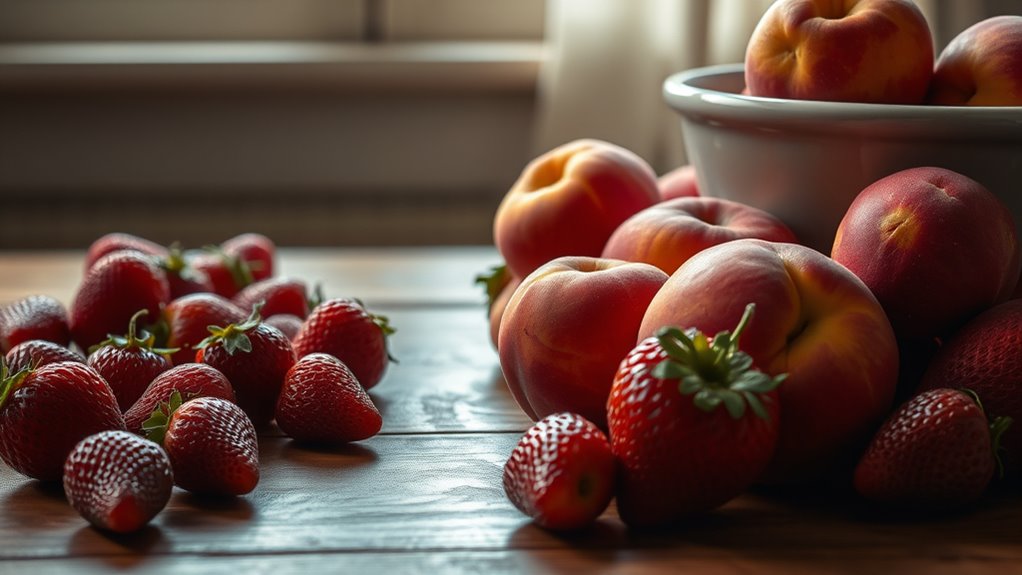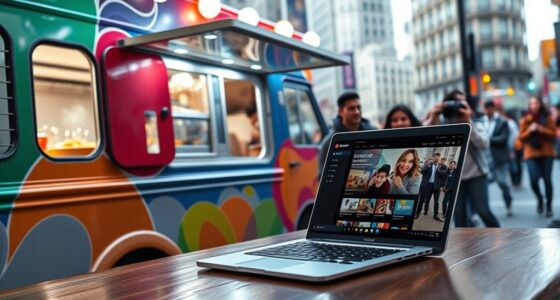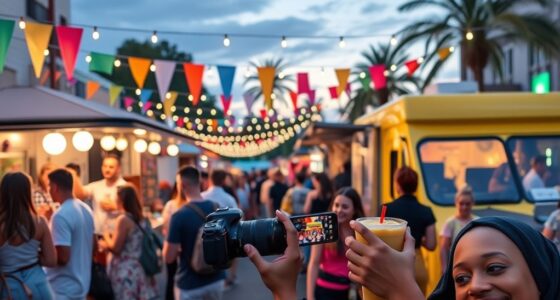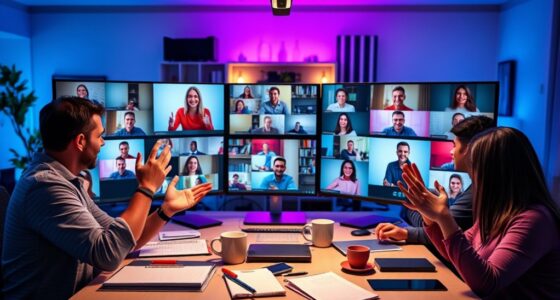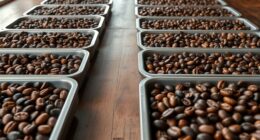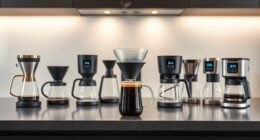To evoke appetite and emotion effectively, choose warm colors like reds and oranges, which boost arousal and create a lively atmosphere. These hues encourage quick and comfortable eating, making them popular in dining spaces. For a calming effect that suppresses appetite, opt for cool shades like blues and greens. Keep cultural associations in mind, as perceptions vary. If you want to learn how to balance these options for the perfect mood, continue exploring these insights.
Key Takeaways
- Use warm colors like reds and oranges to stimulate appetite and create an energetic, inviting atmosphere.
- Incorporate cool colors like blues and greens to promote relaxation and balance stimulating hues.
- Apply color psychology principles to select hues that align with desired emotional responses in food spaces.
- Consider cultural associations of colors to ensure they evoke the intended feelings and avoid misunderstandings.
- Balance stimulating and calming colors to craft a harmonious environment that encourages both comfort and appetite.
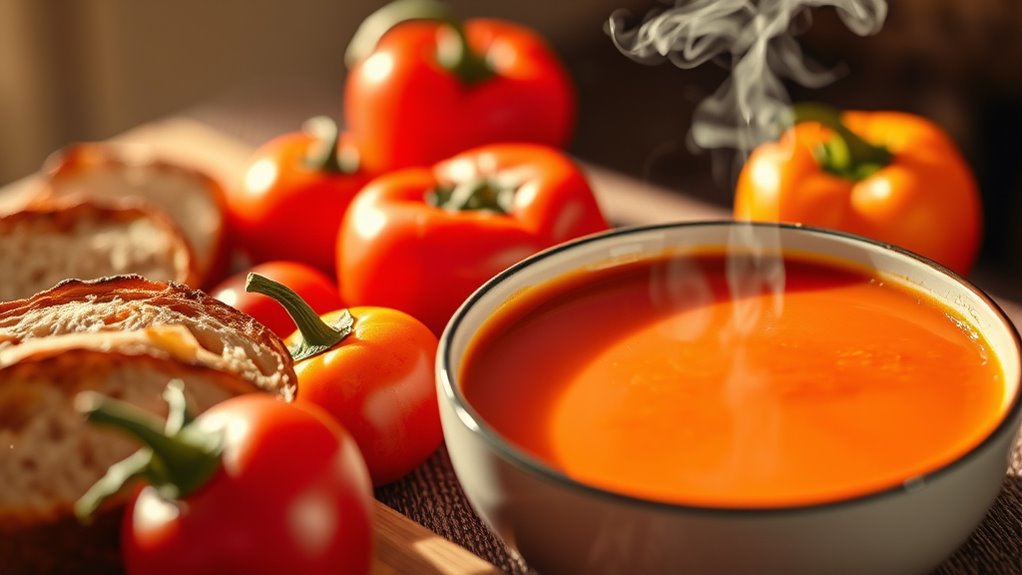
Colors play a powerful role in influencing your appetite and emotions, whether you’re designing a restaurant, a kitchen, or even choosing your dinnerware. Understanding how color psychology principles work allows you to select hues that can stimulate hunger or create a calming atmosphere. For example, warm colors like reds and oranges are known to increase arousal and appetite, making them popular choices in dining environments. These colors can evoke feelings of warmth and excitement, encouraging people to eat more comfortably and quickly. On the other hand, cooler shades like blues and greens tend to have a soothing effect, promoting relaxation but often suppressing appetite. When you’re choosing colors for a space or items related to food, considering these principles helps you craft an environment that aligns with your desired emotional response. Additionally, understanding the psychological effects of colors can help you make more informed choices to achieve the atmosphere you desire. However, it’s essential to recognize that cultural color associations can influence how colors are perceived and their impact on appetite. In some cultures, red is associated with luck, prosperity, or celebration, and it might evoke positive feelings beyond just hunger. Conversely, in other cultures, certain colors may carry different connotations that could alter their effectiveness or appropriateness in a dining setting. For instance, white might symbolize purity and cleanliness in Western cultures, making it a popular choice for dinnerware, but in some Asian cultures, it’s associated with mourning. These cultural nuances mean that the same color can have varying psychological effects depending on the audience. When designing a space or selecting tableware, it’s vital to consider these cultural associations to make sure the colors support the desired emotional response and don’t inadvertently send mixed signals.
Frequently Asked Questions
How Do Cultural Differences Influence Color Perception Related to Appetite?
Cultural differences markedly influence how you perceive colors related to appetite, as cultural symbolism shapes regional preferences. For example, red may stimulate your hunger in Western cultures, while in some Asian cultures, it symbolizes luck and celebration. Your reactions are shaped by these cultural cues, affecting the effectiveness of color choices in marketing or dining environments. Understanding these regional preferences helps you better tailor designs to resonate with diverse audiences.
Can Lighting Impact the Emotional Response to Color in a Space?
Lighting lifts and influences your emotional experience, making it a powerful player in space perception. Your lighting ambiance interacts with color psychology, amplifying or softening the emotional response. Bright, warm lights boost energy and appetite, while dim, cool lighting calms and comforts. So, yes, lighting impacts your emotional reaction to colors, shaping how you feel and respond within a space, creating a cozy, energetic, or tranquil atmosphere.
Are There Specific Color Combinations That Enhance Hunger More Effectively?
Yes, certain color pairings can boost hunger effectively. You should consider warm color combinations like red and orange, which create visual harmony and stimulate appetite. These hues work together to evoke excitement and energy, making food appear more appealing. Incorporate these colors thoughtfully in your space to enhance the dining experience, as a well-balanced color pairing can subtly influence your guests’ desire to eat and enjoy their time.
How Do Personal Experiences Shape Emotional Reactions to Certain Colors?
Your personal experiences act like a paintbrush, coloring your emotional reactions to certain colors. When you see a familiar hue, it can trigger emotional memory triggers that make you feel comforted or uneasy. These personal color associations shape how you respond emotionally, influencing your appetite and mood. Understanding this connection helps you choose colors that resonate with your feelings, making your environment more inviting and emotionally balanced.
What Role Does Color Saturation Play in Stimulating Appetite and Emotion?
Color saturation, or intensity, directly influences your emotional impact and appetite stimulation. Bright, highly saturated colors evoke strong feelings and can make food appear more appealing, boosting your desire to eat. Conversely, muted or low-saturation hues create a calmer, more subdued mood. By adjusting color intensity, you can enhance emotional responses and appetite cues, making your environment more engaging and encouraging positive reactions to your space or food offerings.
Conclusion
So, next time you’re picking a color scheme, remember: it’s not just about making things pretty—it’s about manipulating emotions and appetites. Who knew that choosing the right hue could turn a bland meal into a craving-worthy feast or a dull space into an irresistible haven? But don’t worry, if your choices backfire, you can always blame the color psychology experts—after all, they’re just here to keep your subconscious in check. Happy coloring!
